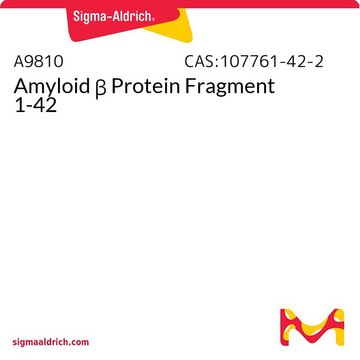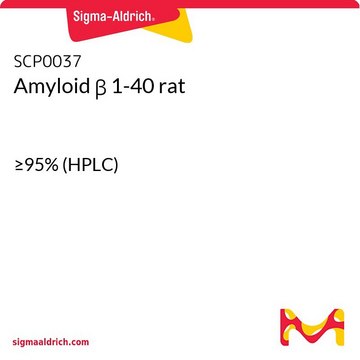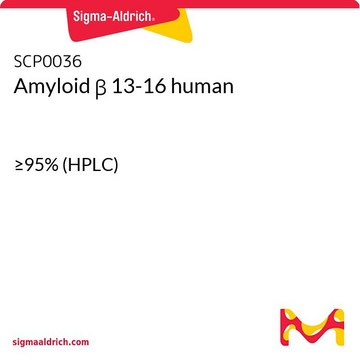About This Item
Wzór empiryczny (zapis Hilla):
C80H115N25O27
Masa cząsteczkowa:
1858.92
Kod UNSPSC:
12352200
NACRES:
NA.32
Polecane produkty
Próba
≥95% (HPLC)
Formularz
lyophilized
skład
Peptide Content, ≥75%
warunki przechowywania
protect from light
temp. przechowywania
−20°C
Amino Acid Sequence
Asp-Ala-Glu-Phe-Gly-His-Asp-Ser-Gly-Phe-Glu-Val-Arg-His-Gln-Lys
Zastosowanie
Amyloid β (Aβ) odnosi się do peptydów pochodzących z białka prekursorowego amyloidu, które różnią się długością od 36-43 aminokwasów. Peptydy Aβ(s), ich fragmenty peptydowe i zmutowane fragmenty są wykorzystywane do badania szerokiego zakresu funkcji metabolicznych i regulacyjnych, w tym aktywacji kinaz, regulacji transportu cholesterolu, funkcji czynnika transkrypcyjnego i regulatorów stanu zapalnego. Peptydy Aβ(s) i ich fragmenty peptydowe są również wykorzystywane do badania stresu oksydacyjnego, wiązania metali i mechanizmów sieciowania białek w kontekście chorób takich jak choroba Alzheimera i neurodegeneracja.
Ta strona może zawierać tekst przetłumaczony maszynowo.
Kod klasy składowania
11 - Combustible Solids
Klasa zagrożenia wodnego (WGK)
WGK 3
Temperatura zapłonu (°F)
Not applicable
Temperatura zapłonu (°C)
Not applicable
Wybierz jedną z najnowszych wersji:
Certyfikaty analizy (CoA)
Lot/Batch Number
Nie widzisz odpowiedniej wersji?
Jeśli potrzebujesz konkretnej wersji, możesz wyszukać konkretny certyfikat według numeru partii lub serii.
Masz już ten produkt?
Dokumenty związane z niedawno zakupionymi produktami zostały zamieszczone w Bibliotece dokumentów.
Maryam Bagheri et al.
Neurobiology of learning and memory, 95(3), 270-276 (2010-12-15)
Alzheimer's disease (AD) is a debilitating neurodegenerative disorder characterized by increased β-amyloid (Aβ) deposition and neuronal dysfunction leading to impaired learning and recall. Ageing, heredity, and induced oxidative stress are among proposed risk factors. The increased frequency of the disease
Aynun N Begum et al.
Journal of Alzheimer's disease : JAD, 15(4), 625-640 (2008-12-20)
The rat amyloid-beta (Abeta) intracerebroventricular infusion can model aspects of Alzheimer's disease (AD) and has predicted efficacy of therapies such as ibuprofen and curcumin in transgenic mouse models. High density lipoprotein (HDL), a normal plasma carrier of Abeta, is used
Lian Hong et al.
The journal of physical chemistry. B, 114(34), 11261-11271 (2010-08-10)
There is no consensus on the coordinating ligands for Cu(2+) by Abeta. However, the differences in peptide sequence between human and rat have been hypothesized to alter metal ion binding in a manner that alters Cu(2+)-induced aggregation of Abeta. Herein
Tania Araujo Viel et al.
Neurobiology of aging, 29(12), 1805-1814 (2007-06-16)
Although numerous inflammation pathways have been implicated in Alzheimer's disease, the involvement of the kallikrein-kinin system is still under investigation. We anatomically localized and quantified the density of kinin B(1) and B(2) receptors binding sites in the rat brain after
Yan Wang et al.
Neuropharmacology, 62(2), 871-881 (2011-10-01)
Alzheimer's disease (AD) is a progressive neurodegenerative disease characterized by the accumulation of β-sheet-rich amyloid oligomers or fibrils which are associated with cellular toxicity in the brain. Inhibition of Aβ aggregation could be a viable therapeutic strategy for slowing and/or
Nasz zespół naukowców ma doświadczenie we wszystkich obszarach badań, w tym w naukach przyrodniczych, materiałoznawstwie, syntezie chemicznej, chromatografii, analityce i wielu innych dziedzinach.
Skontaktuj się z zespołem ds. pomocy technicznej




![[Glu11]-Amyloid β 10-16 human ≥95% (HPLC)](/deepweb/assets/sigmaaldrich/product/images/253/004/4be4057f-fdb4-45f6-950a-d1b2774044c1/640/4be4057f-fdb4-45f6-950a-d1b2774044c1.jpg)



